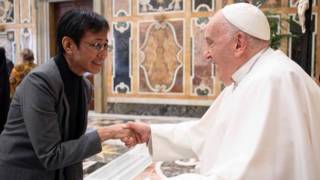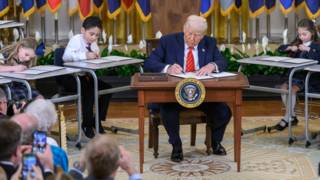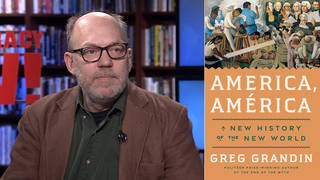
In Mexico, federal police dressed in riot gear stormed the state university in Oaxaca on Thursday where protesters had set up headquarters. It marked the most intense fighting since Mexican President Vicente Fox ordered thousands of federal police into the city to crush the popular uprising. We go to Oaxaca to speak with independent journalist John Gibler. [includes rush transcript]
In Mexico, federal police dressed in riot gear stormed the state university in Oaxaca on Thursday where protesters had set up headquarters. The raid began at about 8 a.m. but eight hours later the police had to retreat after a day of clashes. It marked the most intense fighting since Mexican President Vicente Fox ordered thousands of federal police into the city to crush the popular uprising.
Over the past five months, the residents of Oaxaca–sparked by a teachers strike–had turned the city into an autonomous zone. The police and official government had been kicked out–in its place the protesters formed the Popular Assembly of the People of Oaxaca or APPO. The University has served as a center of operations in part because it houses Radio Universidad. On Thursday, Radio Universidad remained on the air despite the police attacks.
John Gibler joins us on the phone from Oaxaca. He is an independent journalist and human rights fellow with Global Exchange.
- John Gibler. Independent journalist based in Mexico and a Human Rights Fellow with Global Exchange.
Transcript
AMY GOODMAN: On Thursday, [Radio Universidad] remained on the air despite the police attacks.
[Radio Universidad clip]
AMY GOODMAN: That’s Radio APPO at the university. Juan, can you roughly translate what she was saying?
JUAN GONZALEZ: Well, she was saying that they were broadcasting, and they were beginning to give the names of the various students who had been arrested by the federal police.
AMY GOODMAN: Well, we’re joined right now by John Gibler, on the telephone from Oaxaca, an independent journalist and Human Rights Fellow with Global Exchange. Welcome, John.
JOHN GIBLER: Good morning.
AMY GOODMAN: Tell us about the latest and about the centrality of this radio station to the struggle.
JOHN GIBLER: First, from the first day of the struggle, which began its new phase on June 14th, when the state police attempted to violently lift the teachers’ strike from the zocalo in Oaxaca City, the radio has been the backbone of the protesters’ ability to organize their different actions, to call people into the streets for marches, and as well to call for people to gather in places where the protesters are receiving an aggression in the case of a police attempt to move their encampment, or much more seriously, the several cases of paramilitary attacks against protesters. So the radio has been absolutely central to the movement for months now. And the last radio station that the protesters control is, in fact, the university radio station, which has been under their control since June 15th.
Yesterday was an absolutely astounding experience. The police surrounded the avenue that borders the university campus early in the morning and began to clear away barricades from that avenue, which is Eduardo Mata. Protesters gathered on two sides of the campus to face off with the police. And that face-off lasted for about two or three hours, with tensions rising as more students came into the streets, climbing over the university campus walls and coming from surrounding neighborhoods.
Around 11:00 in the morning, police fired tear gas into the university grounds, and at that point the students interpreted that act as an invasion, that they would then be coming into — it was, they said, “Okay, they’re coming into the university now.” And they came out in full force to repel the police line of riot police, using rocks and, to some extent, Molotov cocktails. But mainly, it was just a full thick rain of rocks that hundreds of protesters were hurling at the police.
That set off a battle that lasted in full force for over four hours, with helicopters firing tear gas grenades into the university grounds and along the avenue, riot tanks driving up and down the streets, and protesters constantly rushing, throwing rocks and then pulling back to wipe their faces in Coca-Cola and vinegar, which is their tear gas remedy. Quite effective.
And one thing that’s really important to quickly point out is just the amazing amount of people that started flooding into the streets from just surrounding neighborhoods. Right when the battle began, I noticed that a soccer game in play, the soccer players all stopped, stood dumbfounded for a split second and then ran and scurried to find rocks and joined in with the battle.
JUAN GONZALEZ: John, in terms of the impact of the recent killing of journalist Brad Will, my understand is that there’s been a sudden increase in the amount of press coverage, especially from international and other press, since the shooting of Will. Could you talk about that?
JOHN GIBLER: That is correct, but particularly in the case of the international press. The day after Brad was killed, the airport was swarming with national correspondents from the United States, Canada and other — and European countries. And most of them, in informal conversation, sadly acknowledged the fact that it took a U.S. citizen getting killed for them to even pay attention to the fact that paramilitary forces were shooting people down in the streets of Oaxaca.
AMY GOODMAN: We’re talking to John Gibler, independent journalist based in Mexico and Human Rights Fellow with Global Exchange. John, last night both sides gave their view of what took place. What did the government say? And what do you see coming out of Vicente Fox, the President, now being deeply involved in sending in the thousands of federal police this weekend?
JOHN GIBLER: The commander of the Federal Preventive Police said that the conflict resulted from the university radio station misinforming people in Oaxaca that the police attempted to or were attempting to take over the university radio station. They said that that was never their intention, that they were there only to clear the barricades, but the university radio station made the call, and thus hundreds of people flocked to the streets, and the battle began. Again, from my view on the street, that call came from university students interpreting the firing of tear gas from helicopters into the campus as the beginning of an invasion.
President Fox now has an incredible amount of pressure on his shoulders. Last night, the members of the APPO made a direct call to dialogue with the President. They said that they wanted to go straight to the President, because they felt as if their dialogues with the Interior Minister had not borne any fruit and that they didn’t feel they have the conditions necessary to continue those talks, when they feared that the over 55 people who were detained yesterday might be suffering torture, a fear that’s sustained for them by the fact that those detained during the months of conflict, when released, did show signs of severe torture.
JUAN GONZALEZ: And, John, in terms of the governor of Oaxaca, who’s the main focus of all of the protest, he has been called upon now by the Mexican congress to resign, and he’s still resisting. How do you see his situation right now, in terms of how isolated or how much support he has?
JOHN GIBLER: Every day more and more isolated, though there were two march’s earlier this week of mainly government employees, but still a significant show of people in Oaxaca who do support him. Mostly, again, I found that people in the march were families of government employees.
But the metaphor I use here is the pitbull jaw grip. This guy is just — I don’t know what logic or any logic he might be using, but he is not letting go. He issued a press release last night saying that the people detained during the battle were all from San Salvador Atenco and Chapingo and Mexico City, and that none of these people were actually from Oaxaca, which seems to me patently absurd, because I witnessed the people coming out of their homes, walking from the neighborhoods to fill the streets. But he has never once in the conflict shown the slightest sign of turning away.
And some kind of window into that logic there, when I interviewed people at the support manifestations, the marches and gatherings supporting Ulises Ruiz, I asked them about the paramilitary killings, and systematically everyone there denied that they ever had happened. When I asked about photographs that had been published in mainstream, commercial national newspapers, they said, “Well, those photographs lie.”
AMY GOODMAN: John Gibler, finally, the five men who a local mayor had said had been arrested right after Brad Will was killed — the photograph is there of these men who are believed to have worked for the local government, were police, and ironically a justice of the police. We then learned this week that they had somehow went missing, that they were not in custody. And then we got the report that they are in custody. What’s the latest?
JOHN GIBLER: The latest is that two of the five suspected killers have been detained, but have not been presented to the press yet. That’s one of our chief objectives today, is to try and follow through with that and get confirmed information about their legal status and, as well, those of the three still missing.
AMY GOODMAN: John Gibler, thanks very much for joining us, independent journalist, speaking to us from Oaxaca. And we will continue to cover what’s happening there, and we’ll also, on our website at democracynow.org, post Monday’s show, the hour special we did on Oaxaca.













Media Options